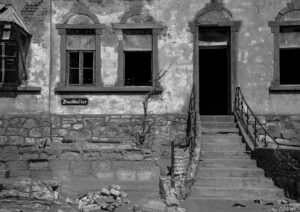
The Ghosts of Kolmanskop
I’m a sucker for a good ghost town. To me, they’re a kind of dissolving testament to the ultimate folly of that most basic of human impulses—greed. These are not the ruins of some once-great ancient civilization. They are the leftover husks of ankle-deep ambition.
The first question that usually comes to mind when visiting one of these places is, what happened? How does a whole town just empty out almost overnight? It’s hard not to wonder what the people here thought as their friends and neighbors began to disappear? I tried to imagine what it must have felt like to be the last person to walk away.
Many ghost towns were clearly designed in a slap-dash manner, never meant for permanence. Occasionally though, you come across one that defies that convention and appears to actually have been built to last, which makes the abandonment seem that much more puzzling.
I recently came across one such place in southern Namibia, a town called Kolmanskop a few kilometers inland from the Atlantic coast town of Lüderitz. Kolmanskop had once been a mining boomtown, the mother lode here being diamonds.
Now though, there was little more than the sound of the wind blowing sand from the surrounding Namib Desert, sand that was slowly reclaiming the town. The effect was striking—inside many of the surprisingly intact and well constructed buildings, the desert’s sand now piled up in doorways and was knee deep in many rooms.
A strange sense of melancholy descended as I surveyed the peeling paint and faded wallpaper of rooms that had once known the vitality of people sharing meals and small talk. These rooms still had remnants of the care and craftsmanship that went into them: detailed moldings, arched window frames, thoughtful wallpaper design, all consistent with the Edwardian mores of the times. From the outside, most of the structures had a distinctly Teutonic sturdiness and style that reflected the sensibilities of their German builders.
Some quick history: Namibia was, at one time, Germany’s late and reluctant colonial stake in southeastern Africa. When diamonds were discovered here in the early 20th century, the boom was on. By 1912, Kolmanskop was supplying about 13% of the world’s diamonds. At first, the diamonds were plentiful and ridiculously easy to find: workers had only to crawl along the ground and pick them out of the sand.
All that diamond wealth brought the perks of civilization to Kolmanskop. An opera hall was built, and butchers, bakers and brewers were imported from Europe. People turned the sand around their homes into gardens with water shipped in by train—the water came in, the diamonds went out.
The good times lasted well into the 1950s when the diamonds finally started to peter out. As the pickings got thin, people began to head south, to the Orange River region near what is now the South Africa-Namibia border where the new diamond finds were. Any commitment to Kolmanskop as a real community by its citizens was apparently only skin deep; by the end of the 1950s, the town had essentially emptied out.
With no one left to act as a bulwark against entropy, the sands of the Namib began their slow reclamation of Kolmanskop. Today, the ghost town has become a bit of a tourist attraction, managed, somewhat ironically, by a diamond mining concern called, ’Namdeb’. In actuality, Namdeb is a combination of the names of the business’s principals: the Namibian government and the De Beers company, the global diamond king.
This little public-private venture lays claim to a vast territory surrounding Kolmanskop—almost 10,000 square miles, which has been declared ’Sperrgebiet’ or ‘Prohibited Area’ and is off-limits to the public because it’s known to have diamonds. This is a bit ironic as whole thing is also a national park, the Sperrgebiet National Park, inaugurated in 2008. It’s the only national park I’ve ever heard of that’s off-limits to the public.
Ironically, this prohibition on human access has made the Sperrgebiet one of the most ecologically pristine places in all of Africa. For over a hundred years, most of the territory has not been touched by humans, and as such, researchers say it harbors a wealth of little understood desert flora and fauna.
The Sperrgebiet’s ‘Off-limits’ status may one day be lifted if and when the De Beers side of the Namdeb partnership decides the Namibian side has a sound management plan for the park. At least that’s the story Namdeb offers when asked about the purpose of a national park that no one can visit.





